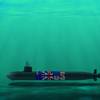Chief of Naval Operations Adm. Mike Mullen and Commandant of the Coast Guard Adm. Thomas H. Collins jointly approved a new National Fleet policy statement in early March aimed at strengthening Navy-Coast Guard cooperation and tailored operational integration of each service’s multimission platforms, infrastructure and personnel.
Building on more than two centuries of close collaboration and joint operations in peace and war, this firm commitment to shared purpose directly supports the new National Strategy for Maritime Security approved by President Bush this past September.
“Security of the maritime domain can be accomplished only by seamlessly employing all instruments of national power in a fully coordinated manner,” the strategy states.
The National Fleet, which originated in 1998, reflects an agreement between the Navy and the Coast Guard to plan, acquire, and maintain forces that support and complement each service’s roles and missions. With this latest update, the services will be able to share assets, providing unique capabilities for expeditionary warfare and maritime homeland defense and security missions.
“While we remain separate services, we recognize that full cooperation and integration of our non-redundant and complementary capabilities must be achieved,” Mullen and Collins said. “This continues to ensure the highest level of maritime capabilities and readiness for the nation’s security and investment.”
“A joint and interoperable maritime force is needed to establish the numerical sufficiency required for effective global operations and to effectively foster and leverage regional international partnerships in order to achieve global maritime domain awareness and maritime transportation security in the era of globalization,” they said.
The Navy-Coast Guard National Fleet has three main attributes. First, it is composed of ships, boats, aircraft, and shore command-and-control nodes that are affordable, adaptable, interoperable, and possess complementary capabilities. Secondly, these forces will be designed, wherever possible, around common command, control, and communications equipment and operational, weapon and engineering systems, and include coordinated operational planning, procurement, training, and logistics. Lastly, the National Fleet will be capable of supporting the broad spectrum of U.S. national security requirements — from power projection to defense of the homeland.
“As the Navy develops shallow water and riverine capabilities, we will seek increasing synergies with the Coast Guard, at home and abroad, exploring complementary design, acquisition, operations and training initiatives,” Mullen testified before the House of Representative’s Armed Services Committee March 3.
He described the new National Strategy for Maritime Security as a “very critical and important document,” and said he and Collins will build on their strong relationship to achieve the level of maritime domain awareness they think vital for the future.
The Coast Guard agrees.
“It is not narrowly constructed as a national counterterrorism plan; it is an all-threat plan including counter-drugs, migrant issues, fishery enforcement, and other security areas — a systems view of the maritime," Collins said recently. "There is a lot of work to be done to give meaning and add meat to those plans, and the Navy and the Coast Guard are engaged in doing that."
The Navy’s contribution to the National Fleet consists of multimission ships, submarines and aircraft, as well as Naval Coastal Warfare, Naval Special Warfare, and C4ISR assets designed for the full spectrum of naval operations, from peacetime engagement to global war. The Coast Guard’s contribution is its statutory authorities, multimission cutters, boats, aircraft and C4SIR, as well as law enforcement and environmental response teams. This contribution, designed for the full spectrum of Coast Guard missions, includes maritime security operations, counterterrorism-crisis response, and filling the joint combatant commanders’ theater plans calling for general-purpose warships.
“Our services have a record of working together that goes back a long way,” Mullen said. “Along with the Marine Corps, our relationship with the Coast Guard is the most critical relationship we can possibly have when it comes to securing the maritime domain.”
By Gordon I. Peterson, Chief of Naval Operations Public Affairs
Subscribe for
Maritime Reporter E-News
Maritime Reporter E-News is the maritime industry's largest circulation and most authoritative ENews Service, delivered to your Email five times per week










